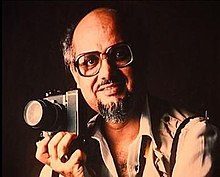Mohamed Amin
This article needs additional citations for verification. (April 2009) |
Mohamed "Mo" Amin | |
|---|---|
 | |
| Born | 29 August 1943 Eastleigh, Nairobi, Kenya Colony |
| Died | 23 November 1996 (aged 53) Indian Ocean near Grande Comore, Comoros |
| Occupation | Photojournalist |
Mohamed Amin MBE (29 August 1943 – 23 November 1996) was a Kenyan photojournalist.
Amin's filming of
Amin died in November 1996 when his flight Ethiopian Airlines Flight 961 was hijacked and crashed into the Indian Ocean near Grande Comore.
Life and work
Amin was born on 29 August 1943 in Eastleigh, Nairobi. He developed an interest in photography at school.[2]
He founded the Camerapix company in 1963 in Dar es Salaam and moved the company to Nairobi three years later. During the 1970s, he became one of the most relied-upon African news photographers,[2] reporting on wars and coups all through the continent, and his pictures were often used by Western news media. Amin's most influential moment came when his filming, along with Michael Buerk's reporting of the 1984 Ethiopian famine brought international attention to the crisis and eventually helped start the charity wave that resulted in Live Aid concerts.[3]
Apart from Ethiopian famine, he contributed exclusive photos of the fall of Idi Amin and of Mengistu Haile Mariam, and was author of numerous books, including Journey Through Pakistan, Pilgrimage to Mecca, and covered various themes like East African Wildlife and the Uganda Railway. Amin also published issues of Selamta, the Ethiopian Airlines in-flight magazine.[4][5]
Amin was not only active in Africa, but also in the Middle East. He covered the Palestinian Black September uprising to seize control of Jordan in September 1970. He was able to move among the Palestinian forces where Western journalists could not.[1]
In 1991, Amin lost his left arm during an ammunition dump explosion in Ethiopia during the Ethiopian Civil War.[6]
Death
Amin boarded
Legacy
In June 2006, Mo and Me, an Al Jazeera documentary film about Amin was premiered. It won Best International Documentary at the Los Angeles International Film Festival. Al Jazeera and Camerapix funded the film. Amin's son, Salim Amin, runs the Camerapix company as of 2008. Mo Amin is the inspiration for the A24 news channel, a proposed independent pan-African 24-hour 'African voice for Africa' which commenced broadcasting from Nairobi on 19 September 2008.
Mohamed Amin worked with numerous journalists and writers, including Tahir Shah and Colin Blane, as well as Michael Buerk.[9]
References
- ^ a b Mitchell, Charlotte. "Mohamed Amin: The Kenyan who moved the world". aljazeera.com. Retrieved 2020-05-25.
- ^ a b Episode One, Mo & Me
- The East African. Retrieved 22 March 2022.
- YouTube
- ^ NGULI, PETER NGANGI. "How Mohamed Amin's lens healed the world". The Standard. Retrieved 2022-03-22.
- ^ a b c "Mohamed Amin, 53, Camera Eye During the Famine in Ethiopia." The New York Times. November 26, 1996.
- ^ "Ocean Landing" or "African Hijack," Mayday
- ^ "Milestones." Time. Monday 9 December 1996. Retrieved on 15 February 2010.
- ISSN 0362-4331. Retrieved 2020-05-25.
Further reading
- Smith, Bob (1998). The Man Who Moved the World: The Life & Work of Mohamed Amin. Nairobi: Camerapix Publishers International. ISBN 1874041997.
External links
- Mohamed Amin Foundation
- "Milestones on December 9, 1996 of Time- Announcement of deaths of Mohamed Amin and Brian Tetley
- INSIDE AFRICA: At the Movies." (Archive) CNN. February 24, 2007. -- interview transcripts, discussing Mohamed Amin and Mo & Me
- Mo & Me - Al Jazeera
- Mohamed Amin at IMDb
